Top 7 places you can't afford to miss in South Korea

Feb 20, 2024 • 6 min read

It may be small, but South Korea packs a punch, from supersonic cities to hiking on Jeju Island © Joel Carillet / Getty Images
Though it may be fun-size compared to its neighbors China and Russia, South Korea more than holds its own when it comes to incredible landscapes, cultural attractions and a dazzling food and nightlife scene.
In fact, South Korea's size paired with its ultra-reliable public transit system is what makes it all so accessible. Travelers can go from mountaintop to beachside or from village to megacity – and back again – in a single day. Not that we recommend rushing your journey – with so many unique places to visit, you could dedicate an entire trip to one spot. Start your travel to-do list now with our seven favorite places to visit in South Korea.
Best place for nightlife
Home to half of South Korea's population, Seoul is also the most popular city for tourists to visit. The capital has an electric vibe at any hour of the day or night. Between the city's low-key watering holes, high-end cocktail lounges and always-fun noraebang (karaoke bars), Seoul has something to offer every late-night reveler.
Some of the newest trendsetting bars are located in Euljiro, while many longstanding favorites are in the tried-and-true nightlife neighborhoods of Gangnam , Hongdae and Itaewon . Gangnam is where the most expensive clubs are concentrated, while Hongdae is a more affordable option for budget-conscious travelers and university students. Itaewon has a reputation for drawing an international crowd.

Best place for maritime culture
Situated on the southern coast, South Korea's second city, Busan , overflows with a maritime culture as lively as it is varied. Setting the tone is Busan Port, the oldest and largest in the country (and also the sixth-busiest in the world), handling some 80% of South Korea's container cargo. The nearby Busan Modern History Museum tells the story of the port's pivotal role in South Korea's history. From there, up and down the coastline are any number of beautiful beaches, parks, observatories, villages and even a temple, Haedong Yonggungsa , one of the country's only oceanside temples.
At Jagalchi , South Korea's largest fish market, the day's catch is arranged in stall after stall of fish, eel, crabs, sea squirts, abalone, and more. Shoppers can select their seafood on the ground level and then take it up to one of the restaurants on the floors above, where the staff will expertly de-scale, de-shell, gut or filet and then cook it for you. For other scrumptious seafood bites, look for restaurants along the beach specializing in jogae gui , grilled shellfish served with a variety of dipping sauces like chogochujang (vinegar red pepper sauce), soy sauce with wasabi, and melted butter with onions.

3. Gyeongju
Best place to discover ancient treasures
As the capital of the Silla Kingdom, when the city was called Donggyeong ("eastern capital"), Gyeongju is a treasure trove of ancient relics, religious to royal. Gyeongju National Museum houses a fair number of them – including ornate jewelry, earthenware jars, prayer bells and Buddha statues – but even more artifacts lie beyond. Gyeongju is known as South Korea's museum without walls.
See the royal tombs of Tumuli-gongwon ; the oldest astrological observatory in East Asia, Cheomseongdae ; the Buddhist grotto of Seokguram ; the picturesque palace of Donggung; and the temple halls, pagodas and bridges of Bulguk-sa . Woljeonggyo, a covered wooden bridge with striking red columns, green roof beams and two end towers, might be the prettiest bridge in all of South Korea – even more so at night when it's illuminated with lights.
Best place for contemporary history
Regarded as the birthplace of Korean democracy, Gwangju was the site of the May 18 Democratic Uprising of 1980, the 10-day-long armed resistance against Chun Doo-hwan's authoritarian military regime. After the brutal repression of some 600 university student protesters, the people of Gwangju stood up and joined in rebellion, resulting in state massacre and torture. Despite the movement's suppression, it's seen as a turning point in South Korea's struggle for democracy.
To better understand this pivotal event in the country's history, go to the May 18th Memorial Park and National Cemetery . You can also take a walk down Chungjang-ro, a now-converted shopping and entertainment street that was once ground zero of the uprising.
Best place for beaches and waterfalls
South of the Korean mainland in the Yellow Sea, Jeju-do is blessed with a balmy subtropical climate, making it the country's most popular vacation destination. The island is in such high demand that the flight between Seoul and Jeju City is the busiest air route in the world. Just one glimpse of Jeju's glittering white-sand and black-sand beaches, crystal-clear waters and volcanic topography of calderas, cones and tuffs, and it's easy to see why so many mainlanders flock to the island for a bit of R&R.
While Jeju's beaches make the perfect natural setting for lounging oceanside with a book and a cocktail, the island has plenty more to do than just relax. Aside from climbing the country's tallest mountain, Hallasan, outdoors adventure seekers can go surfing at Woljeongri or Jungmun beaches, snorkeling and scuba diving at Munseom Island, spelunking in the Geomunoreum Lava Tube System, waterfall chasing at Jeongbang Pokpo or Cheonjiyeon Pokpo , or tewoo rafting aboard a traditional Jeju boat at the Soesokkak Estuary.
6. Gangwon-do
Best place for winter sports
The site of the 2018 Pyeongchang Winter Olympics, Gangwon-do is home to the best ski resorts in South Korea. For skiing and snowboarding, head to top-rated Yongpyong , the country's oldest and largest ski resort, or High1 , featuring a casino and revolving restaurant. Other popular options are Phoenix Park, Vivaldi Park and Alpensia.
The frosty fun doesn't stop there – Gangwon also hosts several winter festivals, including the Hwacheon Sancheoneo Ice Festival , where participants can try ice fishing, curling or sledding, and the Taebaeksan Snow Festival , which puts on enormous ice sculpture and ice fountain displays.

Best place for celebrating folk traditions
The capital of Gyeongsangbuk-do , Andong is also referred to as "the capital of Korean spirit." It is the country's Confucian culture capital, where you'll find traditional wooden masks and soju, the Korean national drink. At Andong's UNESCO-listed Hahoe Folk Village , the most famous folk village in South Korea, visitors can immerse themselves in the old Joseon-era way of life. Peek inside the village's workshops and its special choga homes, distinguished by their straw-thatched roofs, and even book an overnight stay in a guesthouse.
At the Hahoe Mask Museum , you can view the region's quintessential masks, carved into animated expressions to portray characters like aristocrats, servants and monks. Every fall at the Andong Maskdance Festival , you can see them in action in play performances. You can also tour notable Confucian academies, try traditional soju (local vodka) at the Soju Museum or a local restaurant, and sample Andong's signature soy-braised chicken dish, jjimdak .

Explore related stories

Tips & Advice
Sep 3, 2024 • 9 min read
November is the perfect time to give yourself a travel-fueled lift, with destinations primed for exploration during the penultimate month of the year.

Aug 7, 2024 • 10 min read

Aug 5, 2024 • 6 min read
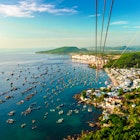
Jul 12, 2024 • 7 min read

Jun 18, 2024 • 13 min read

Mar 28, 2024 • 7 min read

Feb 27, 2024 • 6 min read
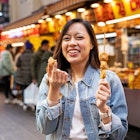
Feb 19, 2024 • 7 min read
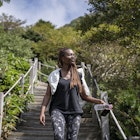
Feb 18, 2024 • 4 min read

Feb 18, 2024 • 7 min read

19 Top-Rated Tourist Attractions in South Korea
Written by Freddy Sherman Updated Mar 20, 2023
Author Freddy Sherman has traveled to South Korea multiple times, including a recent trip to Seoul.
South Korea offers everything a traveler could want in a destination. It has a long and fascinating history, a wonderful culture, amazing food, friendly people, and an excellent tourism infrastructure (including a new high-speed rail system).
It's also a country of contrasts, with tourist attractions ranging from ancient mountaintop Buddhist temples like Bulguksa to the ultra-modern skyscrapers of Seoul, like the Lotte World Tower.
It also has one of the most unique attractions in the world that can be visited: a no man's land, part of a military border between two countries technically still at war (the DMZ). Discover the best places to visit with our list of the top tourist attractions in South Korea.
Experience Korean History at Changdeokgung Palace
Explore beaches and history in busan, visit jeonju, the former spiritual capital of korea, view seoul from above at the n seoul tower, see how people lived 600 years ago at the bukchon hanok village, hike in the mountains at seoraksan national park, look into north korea at the dmz, check out korean art, history, and archeology at the national museum of korea, have fun at korea's largest amusement park, lotte world, gyeongbokgung palace, ride the cable car at hallyeo maritime national park, bulguksa temple, visit the blue house, south korea's white house, enjoy a beach getaway on jeju island, walk through seoul's restored gwanghwamun gate, stay overnight at jingwansa temple, spend a night out in itaewon, enjoy a meal in one of seoul's street food markets, admire cherry blossoms at the jinhae cherry blossom festival, map of tourist attractions in south korea.
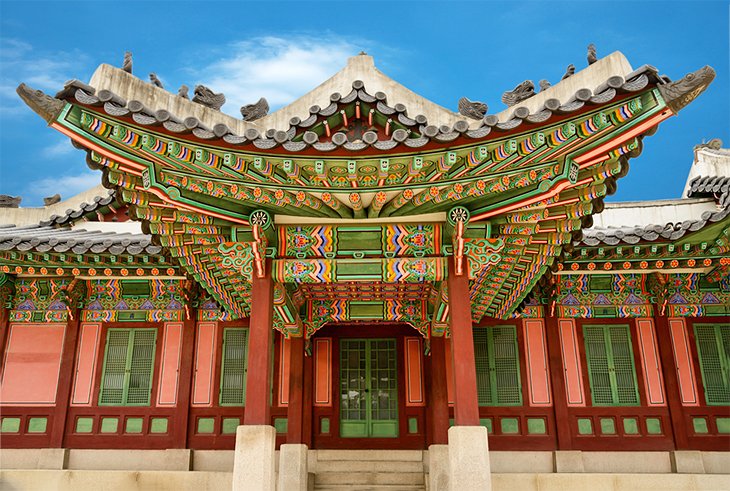
Of the five grand palaces built by the Joseon Dynasty in the 15 th century around Seoul, Changdeokgung Palace was always the preferred royal residence. It's where the king and royal family lived their daily lives.
The palace isn't just a single building, it's a complex of buildings, and each served a different purpose. Some are accommodations; some are libraries, dining rooms, and meeting rooms, among other uses. Be sure to spend some time in the 78-acre Huwon, or palace garden, located behind the palace. It's filled with pathways, green spaces, pagodas, streams, and lakes.
Address: 99 Yulgok-ro, Waryong-dong, Jongno-gu, Seoul, South Korea
Read More: Top-Rated Tourist Attractions in Seoul
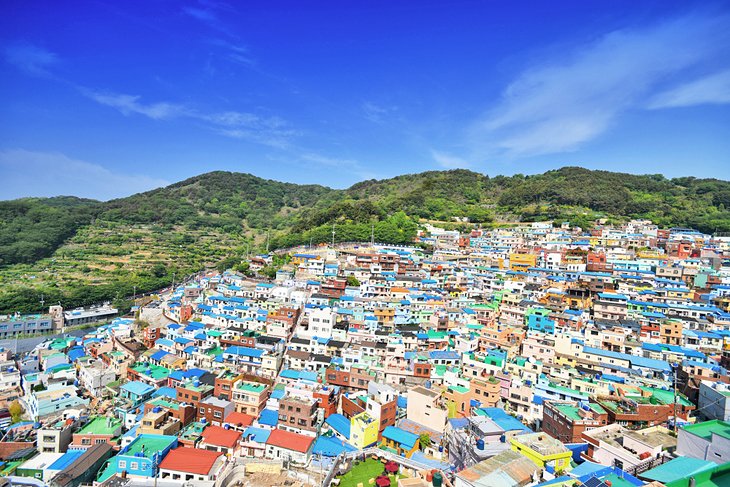
Did you know you can hit the beach in Korea? Busan is the second largest city in the country, and its coast is lined with some beautiful beaches and resorts. There's a lot of culture and history here, too. Be sure to visit the Beomeosa Temple and the hillside village of Gamecheon . Gamecheon is a European-style village on the cliffs above the sea, like Korea's version of Santorini.
Seafood lovers should be sure to visit Jagalchi Market , the country's largest commercial seafood market. Part of the market is open to consumers, and there are many small restaurants that will cook up your purchase, so you can eat it right here.
Getting to Busan is easy, it takes a little more than two hours from Seoul on Korea's KTX high-speed bullet train.
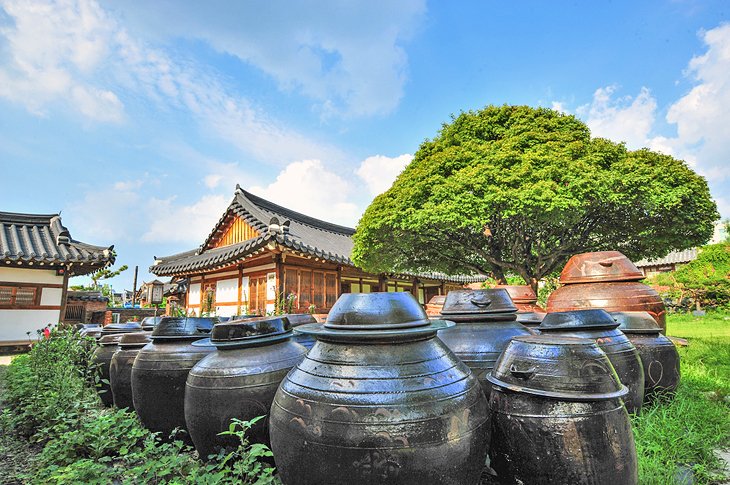
Jeonju is a very historic city, once the spiritual capital of the Joseon Dynasty, it's about 90 minutes by train from Seoul. It's home to many ancient temples and shrines along with a hanok village. These are found throughout Korea. They are preserved neighborhoods of ancient and old homes (hanoks), allowing visitors to get a feel for what life was like in ancient Korea.
Some of the homes in the hanok villages are open for tours, and others have been made into museums (and restaurants and lodging, too), but most remain private homes.
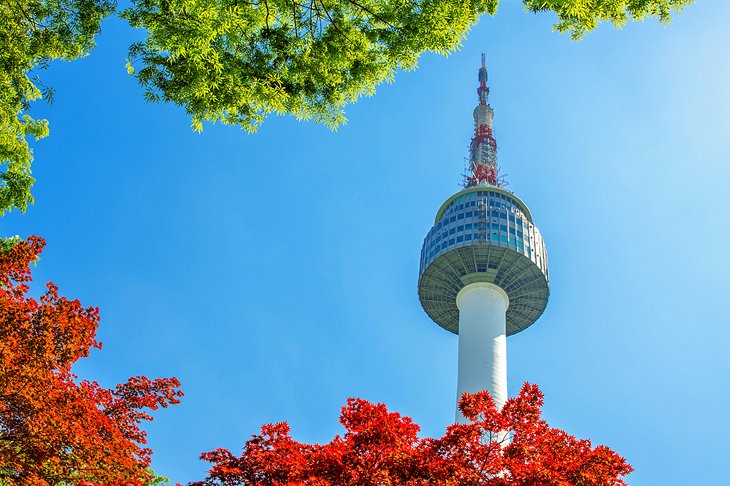
Yes, everyone visiting Seoul should go up in the city's iconic observation tower. Its position almost on top of a mountain, plus the height of the tower itself, gets you almost 500 meters above sea level and the city below.
But, leave some time to explore the surrounding mountain area. The tower is near the top of Mount Namsan, and the entire area is Namsan Park, which is run by the city. There are miles of hiking trails to explore, all within a few minutes of downtown Seoul.
The top levels of the N Seoul Tower include indoor and outdoor observation areas and restaurants. The exterior of the tower is covered in LED lighting, which is illuminated each night in seasonal light shows.
There's a cable car that takes you from the city (near Myeongdong) to the tower's base area. You can then hike from here. After climbing the mountain and riding on the cable car, leave time to explore the Namsan Hanok Village . These preserved historic villages, which are located all over Seoul and Korea, are re-creations of ancient Korean neighborhoods. This village includes five restored hanoks or traditional Korean homes.
Address: 105 Namsangongwon-gil, Yongsan 2(i)ga-dong, Yongsan-gu, Seoul
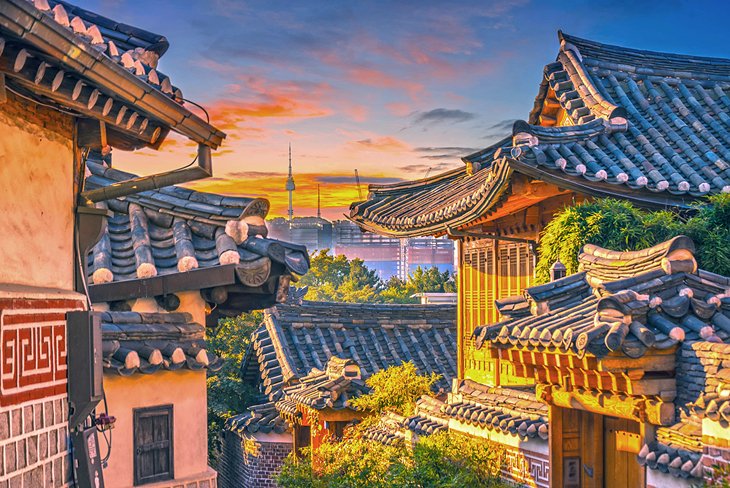
Hanok villages, which can be found in a few places in Seoul and around Korea, are living museums. They're restored and preserved ancient neighborhoods, some in their original location (like Bukchon) and some re-created with hanoks (traditional Korean homes) moved from elsewhere. They give visitors an opportunity to not only experience what it was like to live in a hanok, but also what it was like to live in Korea 600 years ago.
You can experience the tiny, narrow streets and also explore Korean culture, as many of the hanoks are museums or offer cultural demonstrations. Many are private homes, and some offer accommodations. That's what makes these village areas so special; they are true living history because many of the homes are privately owned and occupied by real local residents.
Bukchon Hanok Village is a popular place to explore, as it's right in central Seoul, in the area between the Gyeongbokgung Palace and the Changdeokgung Palace .
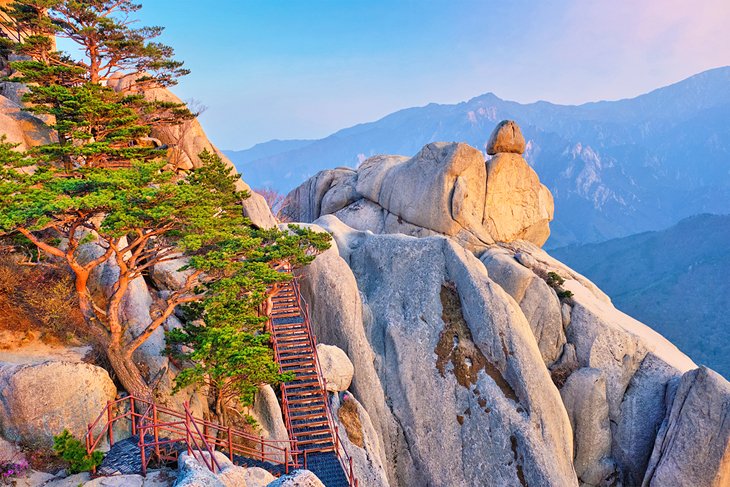
Like the Yosemite of Korea, this majestic natural wonderland (Korea's first national park) has mountains, lakes, waterfalls, streams, and miles of hiking trails that allow you to explore them.
This park is known for its natural diversity, as it has over 1,500 different animal species and over 1,000 different kinds of plants. There are also two Buddhist temples inside the park, one known as the " Temple of a Hundred Pools " due to all the ponds around it fed by mountain streams.
When you get tired of walking, there's a cable car that will take you up Seoraksan Mountain for some incredible views of the mountains and valleys. It takes about four hours by bus or three hours by car to reach the park from Seoul.
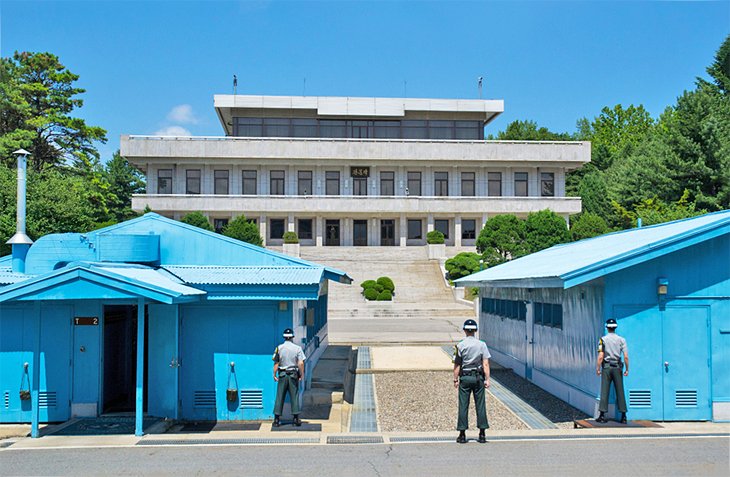
DMZ stands for demilitarized zone, and it's the no-man's land border between North and South Korea. Heavily guarded and mined, this strange area can be visited, but only on an official, guided tour. The official area is about four kilometers wide and is formally known as the JSA or Joint Security Area. It's probably the best place to visit in South Korea to learn about this conflict.
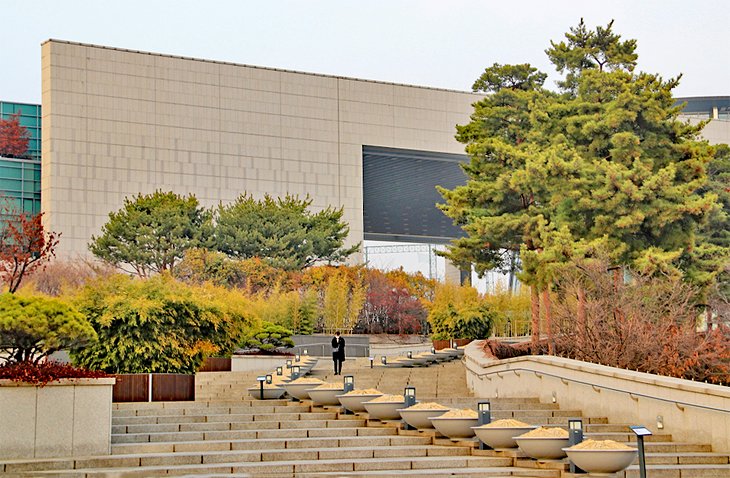
As a world capital, Seoul is filled with a lot of museums. The largest is the National Museum of Korea , and like the Met in New York, it's a place that really can't be explored in a single visit. The vast collection combines art, history, and archeology, presented to show the history of Korean culture and tell the story of the Korean people.
It's also an excellent attraction to see if you only have limited time in Seoul. The collection is beyond vast, as it goes back over a million years. It's fascinating, especially for families and kids as there's such a wide range of objects. Everything from Stone Age tools to modern artwork by Korean artists.
Address: 137 Seobinggo-ro, Seobinggo-dong, Yongsan-gu
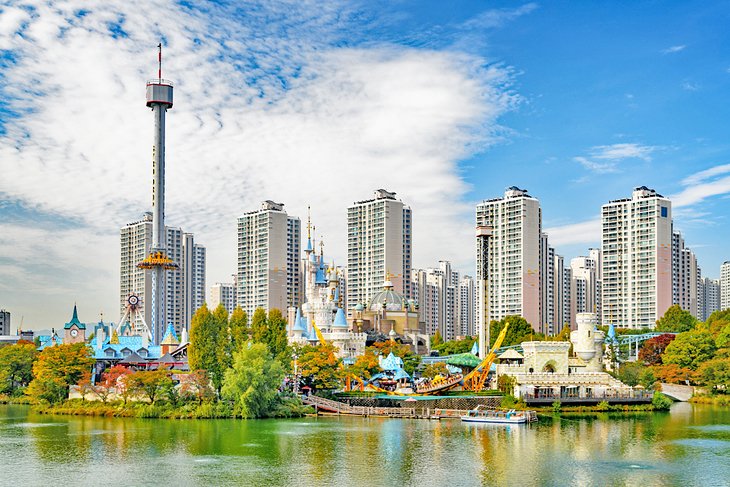
There's an amusement park right in the middle of downtown Seoul. It's a fun place to spend the day and a chance to immerse yourself in real Korean commercial culture. Lotte World includes a hotel, movie theaters (one with the world's largest screen), a folk museum with traditional performances, and other things to do like ice skating.
This theme park is at the base of the Lotte World Tower, the tallest building in South Korea and the fifth tallest building in the world. The tower has multiple observation areas and experiences, its own luxury hotel (the SIGNIEL SEOUL), and a range of shopping and dining options inside.
A visit is fun for both kids and adults, and aside from the rides and attractions there's a lot of shopping and also artists' workshops and cultural performances to watch. There's the world's largest indoor theme park and an outdoor theme park area called Magic Island .
For a bigger, outdoor theme park experience, Everland is about 45 minutes outside Seoul and is Korea's version of Disneyland.
Address: Songpa-gu, Jamsil 6(yuk)-dong, Olympic-ro, 300, Seoul
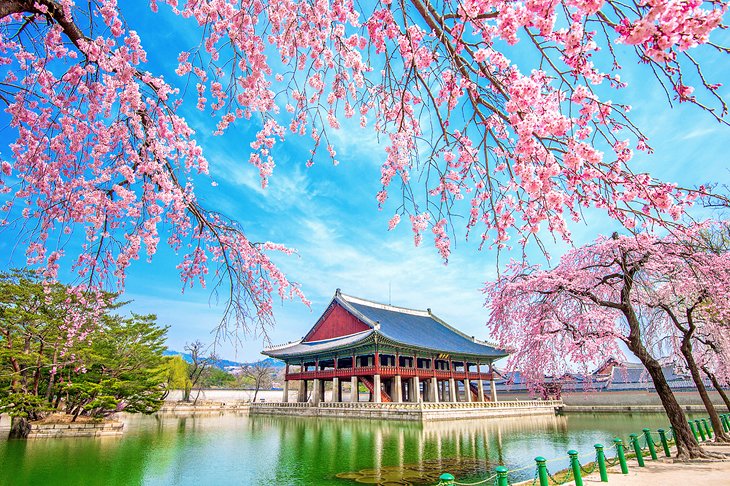
Also known as the Northern Palace, the large Gyeongbokgung Palace complex has gone through some incredible turmoil over the years. It was first built in 1395 during the Joseon dynasty, which built five grand palaces around Seoul. The palace has been bombed, destroyed, and rebuilt several times, occupied by the Japanese (first in 1592), and only finally restored in 1990.
Be sure to check out Gyeonghoeru Pavilion and Hyangwonjeong Pond , two of the remaining original structures from the Joseon period.
The palace compound can be explored on a guided walking tour . There are also two museums inside the grounds (the National Palace Museum and the National Folk Museum ), both worth a visit.
Address: 161 Sajik-ro, Sejongno, Jongno-gu, Seoul
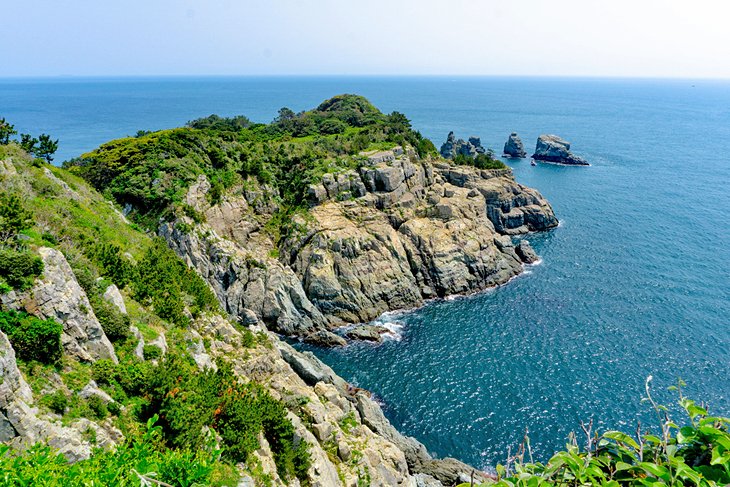
The ruggedly beautiful Hallyeo Maritime National Park includes miles of raw coastline on over 300 separate islands. Each has hiking trails with spectacular ocean and cliff views. The area also features a cable car, known as the Hallyeosudo Viewing Ropeway . It's the only dual-cable, automatic circulating gondola system in the country.
The ride is almost 2.4 kilometers long and takes nine minutes to reach the summit. You're rewarded with sweeping views of the countryside and coastline, including the Japanese island of Daemado. The park is about an hour by bus or car from downtown Seoul.
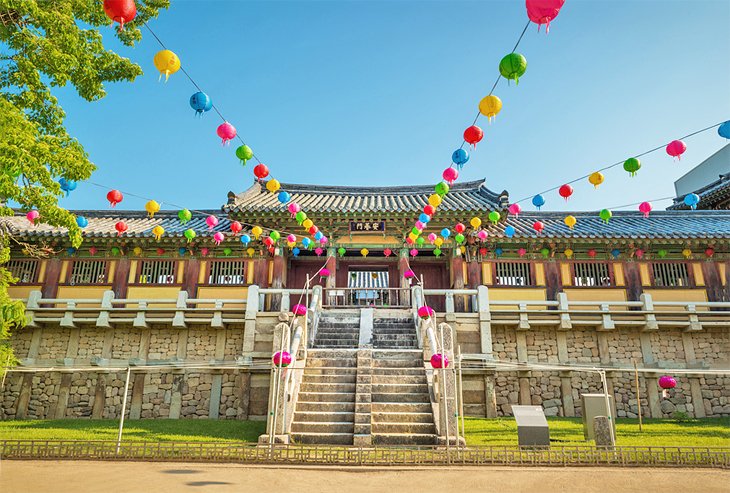
One of Korea's true must-see Buddhist temples, Bulguksa Temple is considered by many to be the country's most important. It's officially Historic and Scenic Site Number One as classified by the government. The temple is home to seven of the country's national treasures, sacred pagodas, and statues of the Buddha.
The temple is on the slopes of Mount Toham in Gyeongju, the ancient capital city of Korea. It's a city so historic, it's called a "museum without walls" due to all the historic sites and temples. Gyeongju is about two and a half hours from Seoul via the new KTX high-speed train.
Address: 15-1 Jinhyeon-dong, Gyeongju, Gyeongsangbuk-do
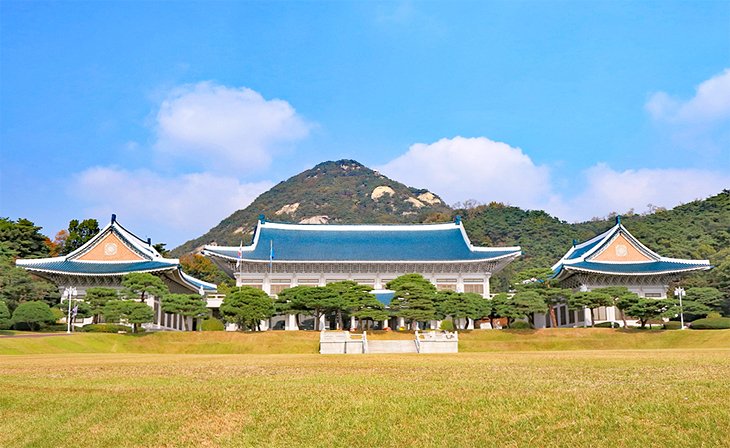
Named for the striking blue-tile roofs of its many pavilions and buildings, the Blue House, much like the White House, is the home of the Korean president. The very secure complex of buildings also houses many Korean executive government offices and official meeting sites. It's an interesting place to visit, as it gives you a behind-the-scenes look at modern Korean government and Korean formal culture.
A lot of what you see on the guided sightseeing tour are meeting rooms and official state reception rooms where foreign dignitaries are welcomed. Hour-long public tours are given, but you need to apply online in advance for a security check.
Address: 1 Sejongno, Jongno-gu, Seoul
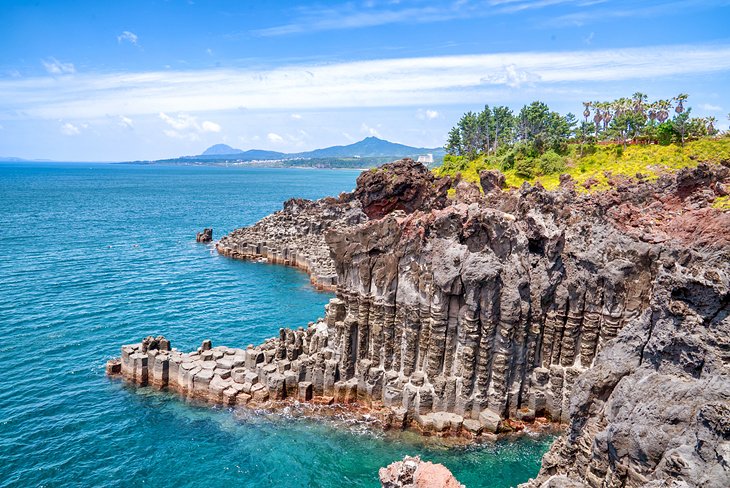
A very popular resort destination (think the Hawaii of Korea), this volcanic island is best reached via a quick hour-long domestic flight from Seoul. The island boasts beautiful beaches along with a lot of culture and history.
The highest mountain in South Korea (a dormant volcano called Hallasan) is here along with miles of giant lava tubes. The lava tubes, which can be explored, are natural air pockets in the hardened lava, the size of railway tunnels.
Be sure to visit Jungmun Beach to see the diving women. These are women who free dive hundreds of feet to catch different types of seafood. This tradition started centuries ago, when the local men were all out on fishing boats. The island also has hundreds of miles of hiking trails and a lot of hot springs and health spas.
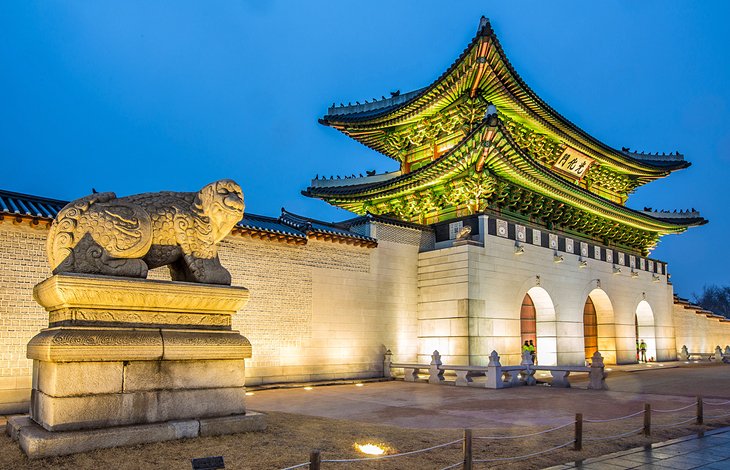
This attraction is a giant gate, formerly the opening in the fortress wall to the Gyeongbokgung Palace located within. It was originally built with the palace in the 15 th century but has been destroyed and rebuilt many times. Most recently in 2010, it was moved back to its original location in front of the palace and Gwanghwamun Square and restored with authentic materials using traditional techniques.
The previous restoration included concrete and other non-traditional construction techniques, but the new gate has been completely constructed with ancient techniques, using only native woods and handmade fittings.
Gwanghwamun Gate is home to the changing of the guards ceremony (performed since 1469), which happens daily (except Tuesdays) at 10am and 2pm. The area in front of the gate, Gwanghwamun Square, is a large public space often used for political and social demonstrations.
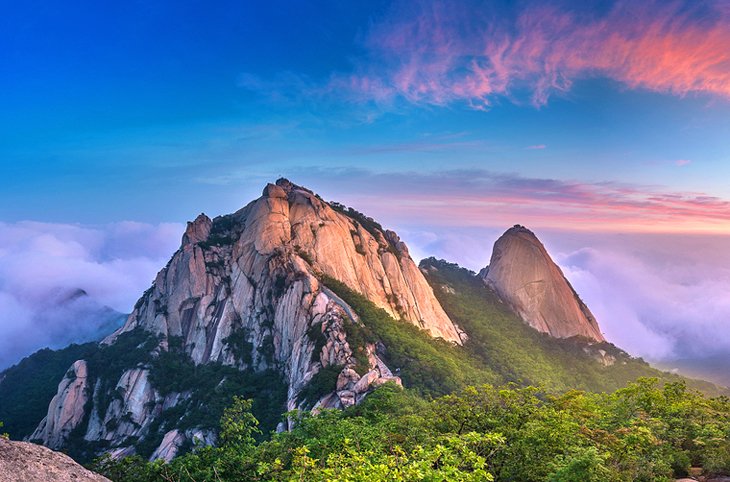
This ancient temple complex about 15 minutes from downtown Seoul offers both an authentic Buddhist temple experience (including a temple stay program) and a beautiful national park. The temple, which was first established at the site in 1,000 BCE, has several programs for visitors to learn about and experience Buddhism and the monk lifestyle.
The temple is a must-visit attraction for foodies, as they grow most of their own food on-site. The temple also prepares its own Korean specialties, like pickling kimchi in ancient, giant pottery jars. Jingwansa offers meals to the public (and extended overnight stays) and educational programs that show the sustainability of the ancient temple operation.
You can do a temple stay program, which includes an overnight visit, or just come for a meal (vegetarian) or to explore the buildings and shrines. You can also visit the area just to explore Bukhansan National Park , as the temple is inside it. There are miles of hiking trails and three peaks, which can be climbed. Aside from the mountains and forests and their spectacular scenery, there are also ruins of an ancient fortress along the hiking trails.
Address: 73 Jingwan-gil, Jingwan-dong, Eunpyeong-gu, Seoul
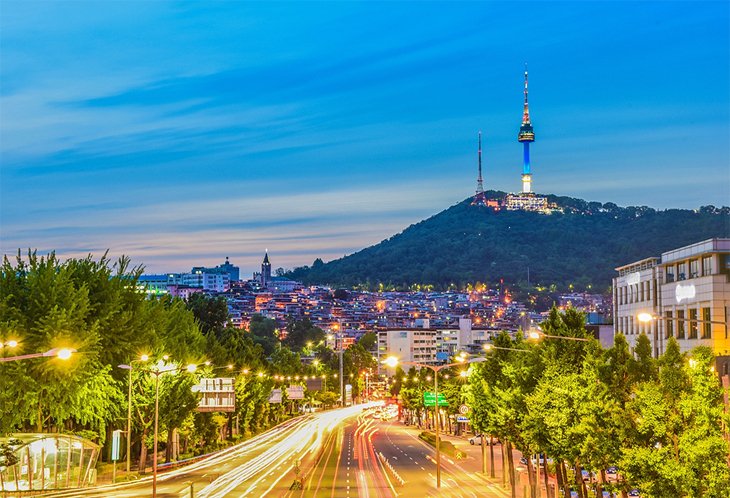
Yes, it's a touristy, ex-pat area filled with gift shops and street food, but the Itaewon neighborhood is a great place to just spend an afternoon wandering around. It's especially fun in the early evening, when residents also come out to grab dinner and people-watch. There's an energy here that defines the cosmopolitan city, and it's also a popular strolling spot for locals. You'll see a lot of Korean families, kids, and couples enjoying the shops and restaurants.
For those in search of authentic Korean food, this is not the place to come, but it is the place to come for international foods not widely available in Seoul. Things like Italian food, pizza, burgers, and American-style western barbecue.
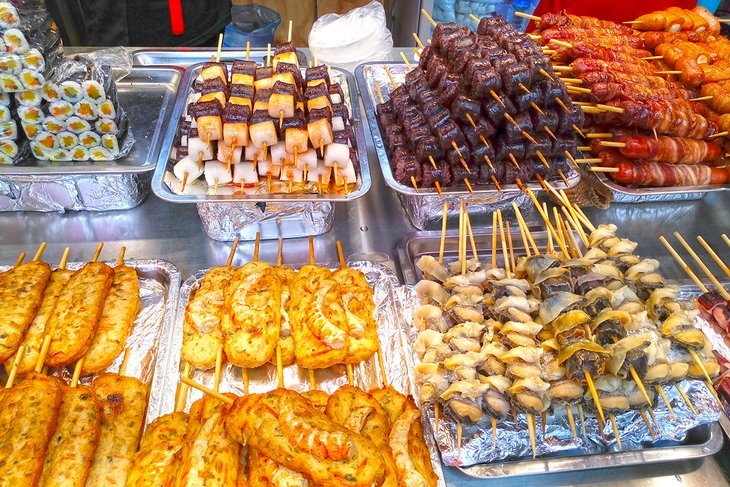
As one of the world's great food cultures, no visit to Korea is complete without enjoying some street food. The Gwangjang Market, in Central Seoul , is truly a foodie heaven on earth. The large covered market area is filled with multiple food stalls offering a complete array of Korean specialties. It's definitely one of the best places to visit in Seoul if you're hungry.
The cool thing about this market and most food markets in Seoul is that the majority of these food stalls are like little mini restaurants in that they have a row of stools and a counter, so you can sit and eat. It's also cool that most stands will offer you a free sample.
Stalls typically offer bindaetteok (mung bean pancakes), bibimbap (rice mixed with sauteed beef, vegetables, and gochujang red chili paste), gimbap (Korean sushi), sundae (blood sausage), tteokbokki (stir-fried spicy rice cakes), and various types of noodles.
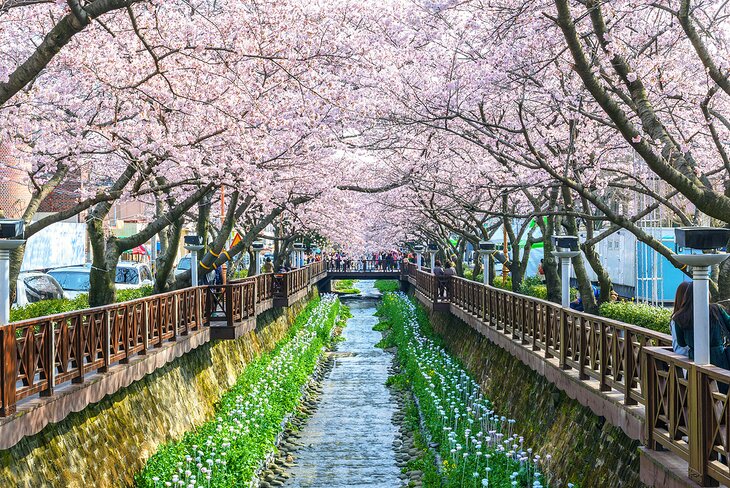
Boasting almost 400,000 cherry trees, some over 100 years old, Jinhae is the best place in Korea to enjoy cherry trees blossoming with flowers each spring. This small town, located along South Korea's southern coast, hosts the country's most popular annual cherry blossom festival. Over a million visitors a year come to Jinhae just to see the cherry blossoms.
Formally known as Gunhangjae (Naval Port Festival), the Jinhae cherry blossom festival takes place in late March or early April, depending on when the trees are in flower. Head to Yeojwacheon stream and Jinhae's Gyeonghwa train station for some of the best blossom viewing. You can also enjoy the festival's food markets, public art installations, and live performances.
Getting from Seoul to Jinhae is easy via South Korea's high-speed ATX train — the journey takes just under three hours.


IMAGES
VIDEO